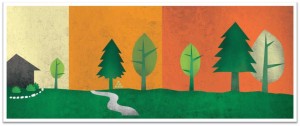Firewise Communities require landscaping around homes to be lean, clean and green. The primary focus on landscaping is in the Home Ignition Zone, of which there are three primary zones:
- Zone 1 – the home and its immediate surroundings, up to approximately 30 feet away
- Zone 2 – 30 feet to 100 feet from the home. In the NWACA area this can be more of a canyon or valley, thickly populated by trees and underbrush.
- Zone 3 – 100 feet to 200 feet from the home; like Zone 2, likely to be thick with trees and underbrush
Home Ignition Zone 1 (All Hazard Areas): Home to 30 feet out. Guidance includes:
Low-flammability plants, landscaping materials, and accessories. Plants should be carefully spaced, low-growing and free of resins, oils and waxes that burn easily. Do not place plants directly against the house nor under or directly in front of windows because should they catch fire, their flame height can be as much as 3-times the height of the plant, endangering the window and creating a fire ladder beside the house. Do not place mulch or cedar chips immediately against the house, as they are flammable. Where possible, create a five-foot wide fire-free bed adjacent to the house and use river stones, gravel or other non-combustible materials.
Mow the lawn regularly and keep grass below 4 inches high. Prune trees up six to ten feet from the ground. Trim trees that overhang the house, so that no limbs touch roofing and damage it in high winds. Remove all dead cedar trees and all dead limbs and branches from living trees (observing Oak tree trimming dates). Make sure irrigation systems are well maintained. Water regularly and keep plant materials green. Consider xeriscaping, to most easily comply with water-use restrictions. No firewood, propane tanks, extraneous wood materials or other combustibles should be stored in this zone, particularly under decks.
Home Ignition Zone 2 (Moderate and High Hazard): 30 feet to 100 feet from the home. Guidance includes:
If this area is beyond your property line, be sure that you have permission from the owners, the Texas A&M Forestry Service, Texas Wildlife, City of Austin, etc. before doing anything in these areas. For areas where permission is granted, trees should be limbed-up 6 to 10 feet above the ground. Remove dead cedar trees and dead limbs and branches from living trees (but observe Golden Cheek Warbler nesting season from March through August and refrain from trimming Oak trees between February and June). If possible, provide 30 feet between tree clusters and 20 feet between individual trees to minimize traveling canopy fire. Remove heavy accumulations of flammable debris.
Home Ignition Zone 3 (High Hazard Areas): 100 feet to 200 feet from the home. Guidance includes:
Again, if this area is beyond your property line, be sure that you have permission to work in the area. Remove heavy accumulation of woody debris. Remove smaller conifers growing between trees, and reduce density of taller trees.
